Italy vs South Africa...
TL;DR: unlike with sport, there's no competition when it comes to wine.
Italy in South Africa
I’ve been on an Italian wine buzz for the last few weeks. Italy and its astounding number of grape varieties has always been a bit overwhelming. Especially when trying to distinguish between the white varieties. In an attempt to save costs in the past, I’d tried learning from South African examples…because, yes, we have a few wines made by passionate producers who are often of Italian descent. A fun (and very South African) story talks about SA winemakers touring Italy in 1992 and smuggling home many of the Italian varieties that are now grown (post Apartheid and KWV reign, these went on to be imported through official channels).
What we got?
Introduced to SA in the 70s, with high quality clones imported in 1991, the number of plantings of Sangiovese has grown from 61.03 hectares in 2011 to 71.19 hectares in 2021 (SAWIS). Sangiovese can be found as far afield as the Northern Cape, Olifants River and the Klein Karoo; as well as most of the usual suspects from the Swartland down to Durbanville.
There are far larger plantings of the multinational Pinot Gris/Grigio - 408 hectares in 2021. Barbera is just under 32, Nebbiolo is around 22, Primitivo/Zinfandel is a bit over 20, and Vermentino sits at 11.8 hectares. Nero d’Avola is largely only one producer holding onto their 7.62 hectares. It’s not nothing, but Italian varieties still amount to only around 1% of SA’s plantings.
Did substituting import duty inflated Old World Italy with affordable New World SA work?
Not without the context of tasting Italy. I’d repeatedly call Sangiovese a modern Nebbiolo…possibly Cab Sauv? Vermentino was ‘like Sauvignon Blanc but not Sauvignon Blanc’. As for Pinot Gris…even after tasting through Alsace, New Zealand and Italy…I still managed to call it meh Chenin Blanc in our final tasting exam last year?!
You now know that I negotiated with my wallet who allowed me to introduce international examples available in our country (and smuggled by dear friends in suitcases). Call it poor planning or an attempt to immerse ourselves in the region, but our evening tasting study group powered through North East, Central and Southern Italy in one sitting…mere hours after spending the day tasting the same high acid wines in lectures…followed by much of the same the next day. Can you say palate fatigue!
Now that I have more distance and less pressure, I’ve returned to the country (through my glass) in an attempt to discover and commit to memory what makes them unique and deducible. Let me tell you, those white wines are delicious in summer but, by and large, I still view them through blurry high acid, lemon tinted glasses. I have not made much progress with the white wines: sometimes more and sometimes less lemon, greater or lower intensity of green apple, sometimes salinity, sometimes metallic minerality…almost always high acidity.
But I have had some revelations with the reds. Immersive deep diving comparative tastings have worked…I think.
I was never sure about Sangiovese/Nebbiolo/possibly Cab Sauv, but now find myself looking for, and finding, the savoury/dusty/clay-earthy/can’t help but crave tomato-based sauce and salami note. Aglianico vs Vino Nobile di Montepulciano vs Barbera vs Barolo. Volcanic minerality vs savoury tomato vs age vs intensity vs tannins. Thoughtful and considered immersion is working.
Is there any worth in including SA wines alongside Italian wines?
What is interesting is that I’m still adding SA examples to these flights. Partly because I’ve found that New World wines tend to focus on the grape variety, whereas the Old World feels defined by appellation laws and terroir. Vino Nobile di Montepulciano with its minimum ageing requirements (70-100% Sangiovese aged for a minimum of 2 years from 1 January after vintage, in addition to a mandatory period of 12–24 months in wood dependent on further bottle ageing; 3 years for Riserva without any oak requirements). Or Rosso di Montalcino that may be sold a year after harvest. Or Chianti and Chianti Classico, and their Riservas, with their varying ageing periods.
Comparing these to South Africa’s Sangiovese offerings:
Il Geco’s 12-month maturation in large 500 litre old French oak barrels
Idiom’s combo of French and American 225l oak barrels for 12-14 months
Similarly, Terra del Capo’s maturation in French and American oak, but using 500 litre barrels for 12 months
Morgenster’s Rigoletta with less extraction and only a few months in neutral oak
Domaine des Dieux’s maturation in older French oak barrels for 18 months
Longridge’s 15-16 month maturation in French oak
With their varying ageing vessels, levels of extraction and flexible ageing periods, the focus remains on the best expression of the winemaker’s interpretation of the grape grown in South Africa. And that’s the beauty of the lawless New World…make yummy wine without the burden of centuries old terroir-guided rules.
The other reason for continuing to compare and contrast Italy against South Africa is a side effect of realising that many of these local producers have a connection to Italy. As much as my wine friend group includes a number of people with clear Italian heritage, I didn’t realise that around 60-70,000 Italians live in SA (according to expatcapetown.com)! Morgenster was started by an Italian who fell in love with our country and moved here in 1992. Ayama have Italian owners who helped plant the first Vermentino vineyards in South Africa. Idiom are owned by a South African Italian family. Il Geco’s forefathers were Italians who emigrated to South Africa. Arcangeli were once Portuguese owned, but are now Italian owned. And those without Italian lineage have a clear passion for the wines.
Re-exploring this intimidating country has helped me understand the reason for that passion. Re-exploring Italian grapes grown on South African soils, raised (in part) by South African hands in the vineyards and cellars, and interpreted through the South African perspective…has had me find a passion for these wines, from both Italy and SA. In terms of wine, the countries lend context to each other (one could say this for most countries, and it expands beyond wine). Don Mattera, the poet, activist and humanitarian is an example of the degree to which the context applies in South Africa. Don is of Italian and Xhosa descent. In Memory is the weapon, his 2009 essay about his life in Sophiatown, he says this of his Italian grandfather:
“ Through them I virtually lived in the farm cottage in his native Italy, and walked among the olive trees eating as I sang. It was my feet that crushed the grapes to make wine, my hands that ground the wheat and harvested potatoes. Even my blood was shed in the long vendettas. I became one with them who I had never seen or touched or spoken to. “
South Africa is truly a melting pot of cultures, Italian included …and, for this reason, no Italian flight in Cape Town is truly complete without including a few local versions.
What I got up to this week (aka I left the house):
I attended Wine Cellar’s New Internationals Arrival tasting. 21 wines on a Wednesday afternoon. Notable moment: tasting champagnes (plural)…this rarely happens. The Willi Schaefer Graacher Riesling Trocken 2021 is stupidly good value at R375. La Rioja Alta Viña Arana Gran Reserva 2015 is bloody delicious…’twas the wine of the afternoon!
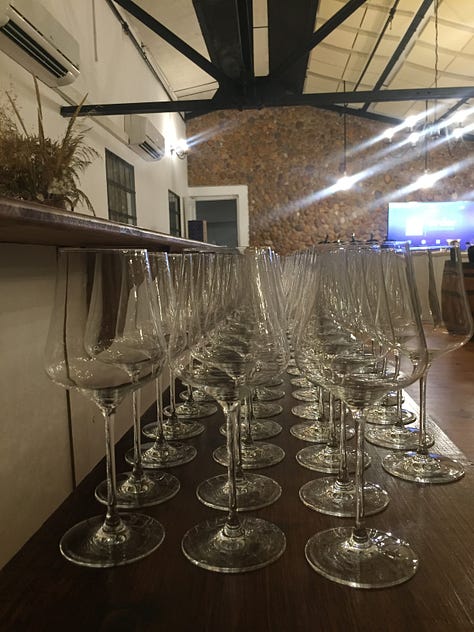
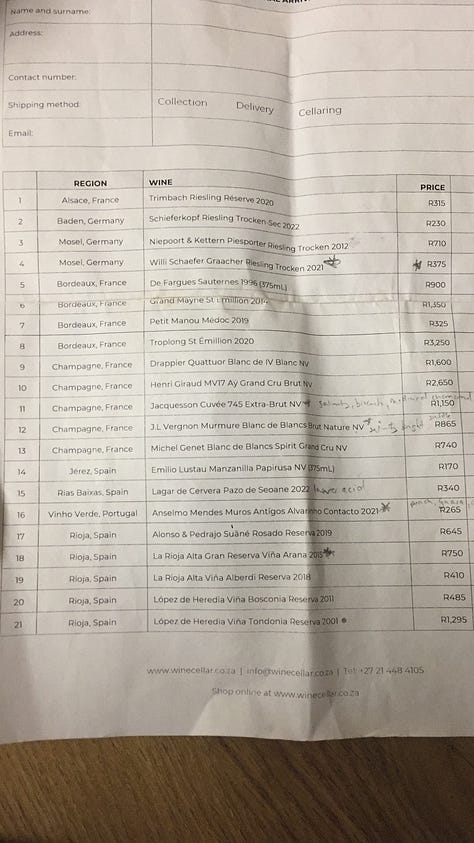

I also had brunch with a friend to celebrate her (and, I suppose, my) graduation. We initially headed for a new-ish spot that’s been appearing on all of the ‘best of’ lists. We saw the queue, had a laugh about how it must have appeared on TikTok, gave up and strolled down to Kloof Street House…an oldie but a goodie with its Victorian themed, curated mismatch of aesthetic charm.
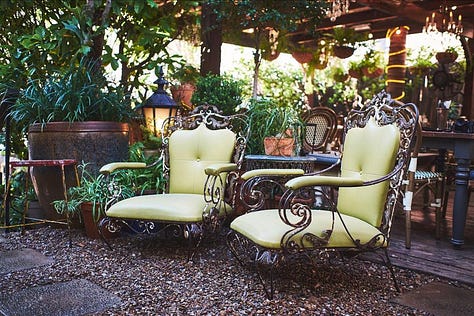


It’s always nice to see friend’s on the wine list, and I was chuffed to spot Migliarina and Thorngrove on the list.
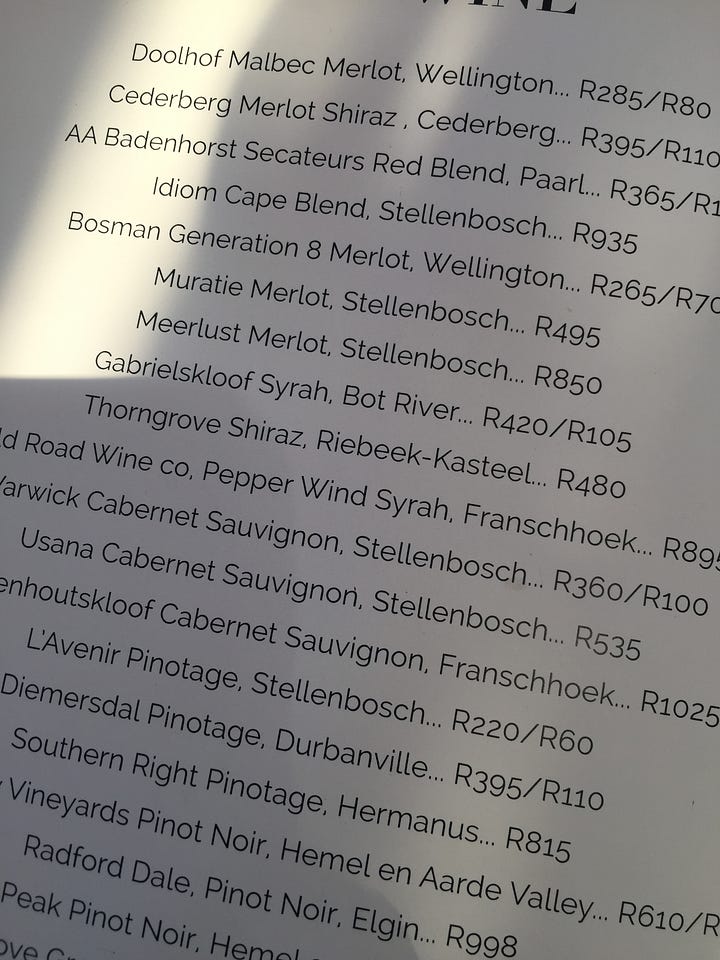
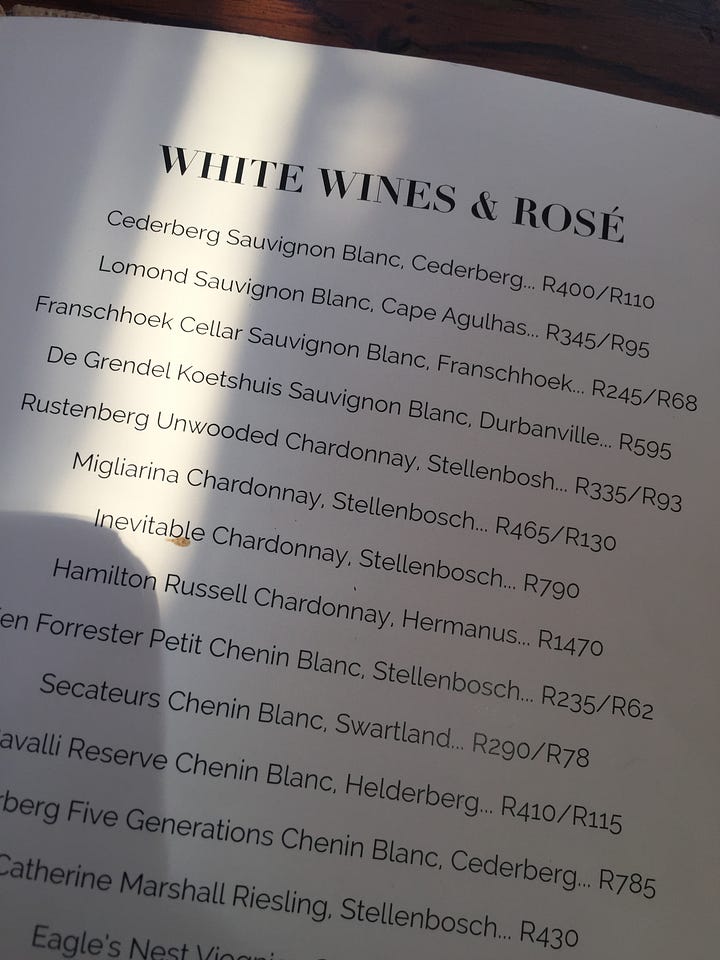
Wine of the Fortnight:
As much as I was revving to taste the 2001 Vina Tondonia Reserva (as a comparison to the 2011 that I’d purchased), the winner was still the La Rioja Alta Viña Arana Gran Reserva 2015. Perfectly balanced, seductive savoury notes, ripe but still fresh, subtle but clear coconut, velvety, and a long finish! Shout out to the Henri Giraud MV17 Aÿ Grand Cru Brut NV…don’t tell anyone…but I’d be happy to contemplate over a full glass of this.
Rando thought of the week?
No random thoughts worth giggling about. Things have been a bit serious these days. Especially with Stage 6 Loadshedding. Hot, humid, no power for up to 4 hours…day drinking to fill those hours…making the hustle to catch up on my lengthy to-do list much slower when the electricity returns. Erm…something that Italy can relate to during the European heatwaves this year 😉 .
Okay, your turn:
Do you also find that tasting New World examples helps to contextualise and understand the OG Old World?




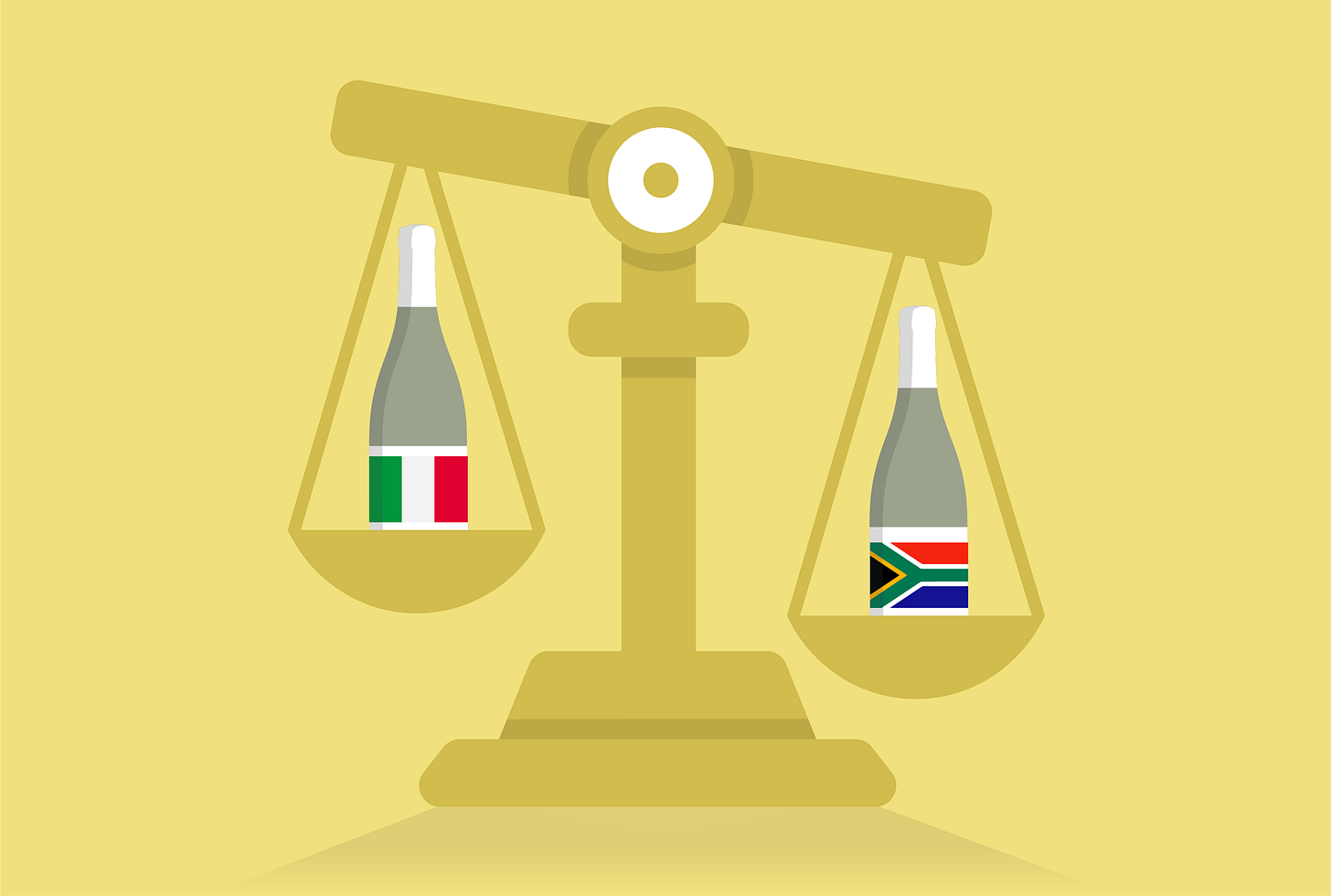





I think tasting New World examples do help to contextualise and understand the Old World wines, especially because the Old World wines are increasingly made in a riper, more New World style. The issue with many of these varieties (I love how you use this word correctly in this context - high five! - as opposed to "varietals" - barf!) is how NW winemakers are often striving for drinkability, instead of letting the grape express itself. In particular, they usually take great care to make high tannin varieties like Nebbiolo and Malbec more accessible in its youth. And that removes quite a bit of its identity.
Yay for joining Team Sangiovese, but I'm totally with you on the whites, especially from the North. Often not interesting enough to warrant the extra spend, with the possible exception of Soave Classico. I do find that whites from the south can have a bit more character; the likes of Falanghina, Fiano di Avelino and Greco di Tufo, but hard to find here.